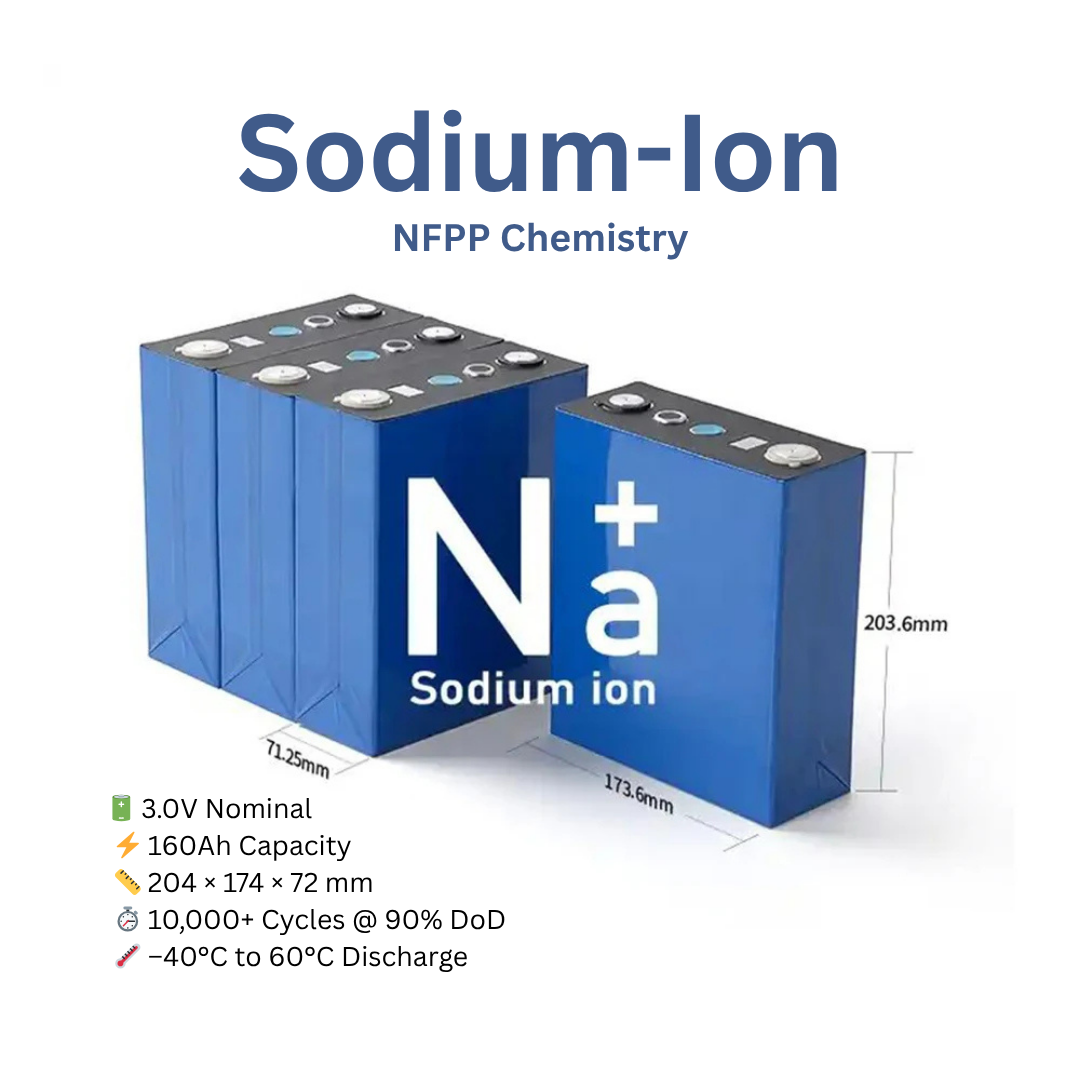OGS-Drop
Sodium Ion 160Ah Prismatic NFPP Cells - Rechargeable Battery SIB Na-ion Cell
Sodium Ion 160Ah Prismatic NFPP Cells - Rechargeable Battery SIB Na-ion Cell
Couldn't load pickup availability
Share
160Ah Sodium-Ion Cell – Industrial-Grade, Lithium-Free Power for Stationary Storage
The 160Ah sodium-ion prismatic cell is built for serious energy storage. This chemistry uses sodium instead of lithium, cobalt, or nickel, and is designed for safety, long cycle life, and cold-weather performance. It’s ideal for off-grid solar, commercial BESS racks, backup power banks, and any application where uptime matters more than watt-hours per liter.
Chemistry: NFPP (high-voltage sodium fluorophosphate polyanion cathode) paired with hard carbon anode. This system supports 3.8 V charge ceiling, 3.0 V nominal, and deep discharge to 1.5 V while delivering 6,000–10,000+ cycles.
📐 Cell Specifications
- Nominal Voltage: 3.0 V
- Nominal Capacity: 160 Ah (≈480 Wh)
- Charge Voltage (max): 3.8 V
- Discharge Cut-off Voltage: 1.5 V
- Standard Charge / Discharge Rate: 0.5 C
- Max Continuous Discharge: 2 C (320 A)
- Pulse Discharge: 3 C for 30 s @ 25 °C (100% SOC)
- Internal Resistance: ≤ 0.65 mΩ (AC @ 1 kHz)
- Cycle Life: ≥ 6,000 cycles @ 80% EOL | ≥ 10,000 cycles @ 70% EOL
- Charge Temperature: 0 °C → 55 °C
- Discharge Temperature: –40 °C → 60 °C
- Recommended Storage: 15 °C → 35 °C at 1.5–3.0 V
- Weight: 4.2 ± 0.2 kg
- Dimensions: 207.2 × 173.7 × 71.7 mm (H × W × T)
- Terminals: Aluminum positive / negative posts
⚡ Performance & Thermal Behavior
- Low-temp discharge: Can discharge at –40 °C. Delivers ≥ 80% of rated capacity at –20 °C (1C discharge to 1.5 V after standard charge).
- High-temp discharge: After soaking at 55 °C, delivers ≥ 96% of rated capacity (1C discharge to 1.5 V).
- Charge retention: ≥ 90% capacity after 30 days at 25 °C. Capacity recovery ≥ 95% after recharge.
- Compression spec: Designed for pack assembly under ~200–300 kgf preload to maintain performance and cycle life.
🔒 Safety & Abuse Test Results
The PORFFOR SIB-P71173208-160Ah cell passed the following abuse tests with no fire, no explosion:
- Overcharge: Forced to 6.0 V @ 1C – no fire / no explosion.
- Short Circuit: External short < 5 mΩ for 10 min – no fire / no explosion.
- Crush: Pressed perpendicular to plates up to 200 kN or 30% deformation – no fire / no explosion.
- Heat: Heated to 130 °C and held 30 min – no fire / no leakage.
- Drop: 1.5 m drop onto concrete – no fire / no explosion.
- Seawater immersion: Fully submerged in 3.5 wt% NaCl solution for 2 hours – no fire / no explosion.
- Thermal cycling: –40 °C to 85 °C cycling (5x) – no fire / no explosion.
Translation: this chemistry is extremely hard to ignite compared to typical lithium-ion cells.
🧪 NFPP vs Layered Oxide – Which Sodium-Ion Chemistry Is This?
This cell is an NFPP fluorophosphate polyanion sodium-ion cell (high-voltage Na₃V₂(PO₄)₂F₃ cathode + hard carbon anode), not a layered oxide cell and not Prussian Blue.
| Characteristic | Layered Oxide | NFPP (Polyanion) |
|---|---|---|
| Voltage Window | ~2.0 – 4.0 V | 1.5 – 3.8 V |
| Cycle Life | ≈3,000 cycles typical | 6,000–10,000+ cycles |
| Thermal Stability | Moderate | Very high / non-flammable behavior in abuse tests |
| Best Use Case | Mobility / where pack voltage and Wh/L matter | Stationary ESS, off-grid solar, backup power, telecom racks |
🛠 Integration Notes (Read Before Building a Pack)
- BMS required: Cell must be used under an external BMS that manages over/under-voltage, current, high temp, and active balancing between cells.
- Do not charge above 3.8 V/cell. Overcharge beyond 3.8 V is prohibited.
- Do not discharge below 1.5 V/cell. Going below this risks permanent damage.
- Thermal design: Enclosures must manage heat and avoid hotspots. OEM is not responsible for damage caused by enclosure thermal issues.
- Environmental sealing: Pack/box must be designed to meet appropriate dust/water ingress protection. Corrosion from moisture is considered integrator risk.
- Mixing cells: Do not mix different part numbers or revisions in the same pack.
🚢 Logistics & Lead Time
- Currently we have US stock in Michigan.
- Pricing assumes U.S. mainland (typical ~45 days door-to-door).
- Air freight not available.
- If US stock is depleted, then ships directly from China.
View datasheet (PDF)




















